

Realistic Agri - Model Pro-90 - Glucogenic Energy Source for Dairy Cows and Calves
Pro-90 is a specialized glucogenic energy solution formulated for dairy cows and calves, addressing the significant energy demands during the critical transition period from dry to milking phases. It contains a concentrated blend of glucogenic energy sources, energy precursors, bypass sugar, and vitamin B complex, enhancing the efficacy of propylene glycol within the liver. This product is particularly beneficial in preventing and treating both clinical and subclinical ketosis by promoting the safe utilization of body fat, thereby diminishing the accumulation of ketone bodies and high BHBA blood levels. With its ability to stimulate appetite and transition cows to a positive energy balance, Pro-90 not only assists cows in getting in calf more easily but also improves milk production quality and quantity. Its formulation offers superior value compared to straight propylene glycol and glycerine, with minimal dosage requirements, and comes in both liquid and meal forms suitable for oral dosage or feed integration.
Taking the risk out of transition.
Pro-90 is a concentrated glucogenic energy source for dairy cows and calves. Pro-90 contains an energy source, two energy precursors, bypass sugar and vitamin B complex to activate the process, maximising the effect of the propylene glycol in the liver.
Pro-90 is recommended for the prevention and treatment of ketosis, both clinical and subclinical. It will stimulate the appetite of freshly calved cows, especially for forage. It does this by enabling the safe utilisation of body fat, reducing the build up of ketone bodies and the resulting high level of BHBA in the blood stream.
It is a proven, reliable and effective treatment and returns many times over the cost of treatment by preventing reduced performance thereby giving extra production in treated cows.
Pro-90 effectively moves calved cows from a negative to a positive energy balance in a much shorter period of time. Cows then get in calf more easily and will produce more and better quality milk. It is available as a liquid or a meal which can be dosed orally or mixed into or put on top of feed. The dose rate is low in comparison to products such as straight propylene glycol and glycerine, thereby offering better value for money.
The transition phase from dry cow to milking is the most problematic time for a cow.
If she is not in the right condition or is stressed at this time, it will have negative implications for the whole lactation and may even result in culling. Some of the problems encountered at transition range from ketosis (acetonaemia), metritis, fatty liver and milk fever, among many others! The risk of these problems is minimised by using Pro-90.
Some of the problems, especially something like ketosis and fatty liver, originate by failure of the regulation of the processes which control the transformation of fat into energy. If there is too much fat converted to energy, there is a build-up of ketone bodies in the blood resulting in the usual symptoms of ketosis including:
- Depressed milk yield.
- Rapid weight loss.
- Better appetite for hay compared to silage or grain.
- “Sweet” smelling breath.
Sub-clinical ketosis is, by definition, very difficult to recognise. Blood testing is one way to confirm that it is a problem but it usually starts with a hunch that cows “just aren’t milking right”.
Sub-clinical ketosis can be diagnosed using a blood serum test measuring beta-hydroxy butyric acid (BHBA). The level at which subclinical ketosis occurs is disputed but a level of around 1.0 mmol/litre is fairly accepted as the upper level of safety. A cow with a blood level of over 3.0 mmol/l would generally be showing symptoms of clinical ketosis as described above.
